
OPTIONS
- If the selected option is not compatible with the set wash cycle, the
indicator light will ash and the option will not be activated
Delay start
To set a delayed start for the selected cycle, press the corresponding
button repeatedly until the required delay period has been reached. To
remove the delayed start setting, press the button until the text “OFF”
appears on the display.
Temperature
Each wash cycle has a pre-dened temperature. To modify the
temperature, press the button. The value will appear on the display.
Spin
Each wash cycle has a pre-dened spin speed. To modify the spin speed,
press the button. The value will appear on the display.
Drying
The rst time the button is pressed, the machine will automatically
select the maximum drying cycle which is compatible with the selected
wash cycle. Subsequent presses will decrease the drying level and then
the drying time, until the cycle is excluded completely (“OFF”).
Drying may be set as follows:
A - Based on the desired laundry dryness level:
Iron “A1”: suitable for clothes which will need ironing afterwards. the
remaining dampness softens creases, making them easier to remove.
Hanger “A2”: ideal for clothes which do not need to be dried fully.
Cupboard “A3”: suitable for laundry which can be put back in a
cupboard without being ironed.
B - Based on a set time period: between 30 and 210 minutes.
If your laundry load to be washed and dried is much greater than the
maximum stated load, perform the wash cycle, and when the cycle is
complete, divide the garments into groups and put some of them back
in the drum. At this point, follow the instructions provided for a “Drying
only” cycle. Repeat this procedure for the remainder of the load. A
cooling-down period is always added to the end of each drying cycle.
Drying only
Press button to perform the drying-only cycle.
After selecting the desired cycle (compatible with the type of garments),
press button to exclude the washing phase and start the drying
phase at the maximum level for the selected cycle. The drying level or
time may be set and changed by pressing the drying button .
Cleaning Action
Option makes it possible to optimise washing based on the level of
soil in the fabrics and on desired wash cycle intensity.
For heavily-soiled garments press button until the “Intensiv” level
is reached. This level ensures a high-performance wash due to a larger
quantity of water used in the initial phase of the cycle and due to
increased drum rotation. It is useful when removing the most stubborn
stains.
For lightly-soiled garments or a more delicate treatment of the fabrics,
press button until the “Sanft” level is reached. The cycle will reduce
drum rotation to ensure washing results that are perfect for delicate
garments.
CHILD LOCK
To activate the control panel lock, press and hold the button for
approximately 2 seconds. When the symbol is lit, the control panel is
locked (except for the ON/OFF button). This will prevent accidental
modications to wash cycles, especially when children are at home. To
deactivate the control panel lock, press and hold the button for
approximately 2 seconds.
TIPS AND SUGGESTIONS
Divide the laundry according to:
Type of fabric (cotton, mixed bres, synthetics, wool, garments to be
hand-washed). Colour (separate coloured garments from whites, wash
new coloured garments separately). Delicates (small garments – such as
nylon stockings – and items with hooks – such as bras: insert them in a
fabric bag).
Empty the pockets:
Objects such as coins or lighters can damage the washer-dryer and the
drum. Check all buttons.
Follow the dosage recommendation / additives
It optimizes the cleaning result, it avoids irritating residues of surplus
detergent in your laundry and it saves money by avoiding waste of
surplus detergent.
Use low temperature and longer duration
The most ecient programmes in terms of energy consumption are
generally those that perform at lower temperatures and longer duration.
Observe the load sizes
Load your washing machine up to the capacity indicated in the “Wash
Cycle Table” table to save water and energy.
Noise and remaining moisture content
They are inuenced by the spinning speed: the higher the spinning speed
in the spinning phase, the higher the noise and the lower the remaining
moisture content.
CARE AND MAINTENANCE
Before performing cleaning and maintenance, switch the washer-dryer o
and disconnect it from the mains power. Do not use ammable liquids to
clean the washer-dryer. Clean and maintain your washer-dryer periodically
(at least 4 times per year).
Cutting o the water and electricity supplies
Close the water tap after every wash. This will limit wear on the hydraulic
system inside the washer-dryer and help to prevent leaks.
Unplug the washer-dryer when cleaning it and during all maintenance
work.
Cleaning the washer-dryer
The outer parts and rubber components of the appliance can be cleaned
using a soft cloth soaked in lukewarm soapy water. Do not use solvents or
abrasives.
The washer-dryer has a “Self-Cleaning” cycle for its internal parts; it must
be run without any load in the drum.
To optimise this cycle, it is possible to use either detergent (10% of the
quantity specied for lightly soiled garments) or special additives to clean
the washer-dryer. We recommend running a cleaning cycle every 40 wash
cycles.
To start the programme press button for 5 seconds.
The cycle will start automatically and will run for about 70 minutes. To
stop the cycle, press the START/PAUSE button.
Cleaning the detergent dispenser drawer
Remove the dispenser drawer by lifting and pulling it outwards. Wash it
under running water; this procedure should be eected regularly.
Caring for the door and drum
Always leave the porthole door ajar in order to prevent unpleasant
odours from forming.
Cleaning the pump
The washer-dryer is tted with a self-cleaning pump that does not require
any maintenance. Small items (such as coins or buttons) may sometimes
fall into the protective pre-chamber situated at the base of the pump.
! Make sure that the wash cycle has ended and unplug the appliance.
To access the pre-chamber:
1. remove the covering panel on the front side of the machine by
inserting a screwdriver in the centre and sides of the panel and using it as
a lever;
2. loosen the drainage pump cover by turning it anti-clockwise: it is
normal for some water to leak out;
3. clean the inside thoroughly;
4. screw the cover back on;
5. put the panel back in place, making sure the hooks slot in place before
pushing the panel onto the appliance.
Checking the water inlet hose
Check the water inlet hose at least once a year. If it is cracked or broken, it
must be replaced: during wash cycles, the high pressure of the water
could suddenly split the hose open.
! Never use hoses that have already been used.
ACCESSORIES
Contact our Technical Assistance Service to check whether the following
accessories are available for this washer-dryer model.
Stacking kit
With this accessory you can secure the tumble dryer to the upper part of
your washer-dryer to save space and facilitate loading and unloading of
the tumble dryer.
TRANSPORT AND HANDLING
Do not lift the washer-dryer by gripping it from the upper section.
Unplug the appliance and close the water tap. Check that the door and
detergent dispenser drawer are tightly closed. Detach the lling hose
from the water tap then detach the drain hose. Empty all the water
remaining in the hoses and secure the latter so that they do not get
damaged during transport. Apply the transport bolts back on. Repeat, in
reverse order, the transport bolt removal procedure described in the
“Installation instructions”.

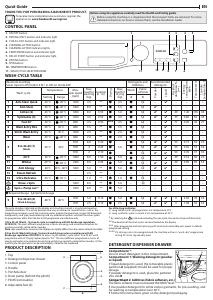


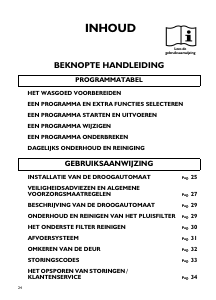
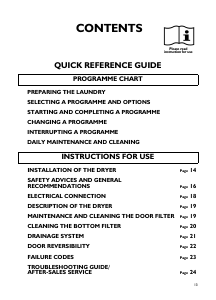
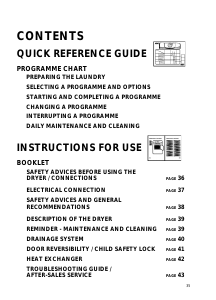
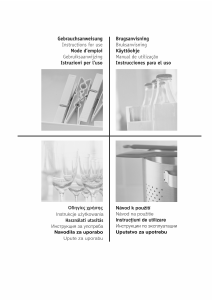
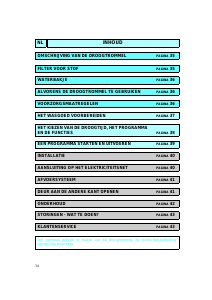
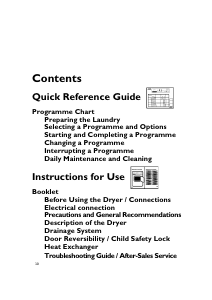
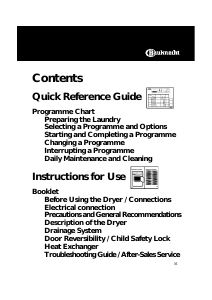
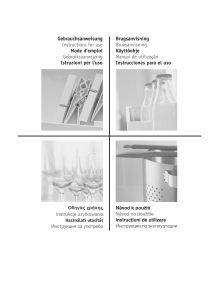
Praat mee over dit product
Laat hier weten wat jij vindt van de Bauknecht WT Super Eco 8514 N Wasdroger. Als je een vraag hebt, lees dan eerst zorgvuldig de handleiding door. Een handleiding aanvragen kan via ons contactformulier.